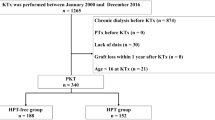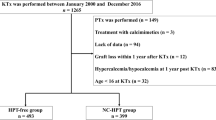Abstract
Secondary hyperparathyroidism (HPTH) is a frequent complication of chronic kidney disease (CKD). Renal transplantation corrects the biochemical abnormalities that cause HPTH; however, HPTH persists in some patients. The factors that contribute to the persistence of HPTH after transplantation in children are poorly understood. We examined 57 children who underwent renal transplantation and determined whether baseline clinical and biochemical parameters could predict the persistence of HPTH at 1 year post-transplantation, using multivariate logistic regression. At the time of transplantation, serum parathyroid hormone (PTH) levels were >300 pg/ml in 60%, 150–300 pg/ml in 17%, and <150 pg/ml in 23% of recipients. HPTH (PTH >73 pg/ml) persisted in 78% of patients at 6 months and in 56% at 1 year after transplant. Older age at transplantation was the strongest predictor of HPTH at 1 year (OR=1.17, P<0.05). After adjustment for age, other baseline clinical or laboratory parameters were not predictive of HPTH at 1 year. The relationship between older age and persistent HPTH may be explained by longer duration of CKD. Given the potential morbidities associated with persistent HPTH, the role of interventions that would prevent or reverse persistent HPTH post-transplantation requires further investigation.

Similar content being viewed by others
References
K/DOQI (2003) Kidney Disease Outcomes Quality Initiative: clinical practice guidelines for bone metabolism and disease in chronic kidney disease. Am J Kidney Disease 42:[Suppl 3]
Feber J, Cochat P, Braillon P, Castelo F, Martin X, Glastre C, Chapuis F, David L, Meunier PJ (1994) Bone mineral density after renal transplantation in children. J Pediatr 125:870–875
Feber J, Braillon P, David L, Cochat P (2001) Body composition in children after renal transplantation. Am J Kidney Dis 38:366–370
Morel P, Almond PS, Matas AJ, Gillingham KJ, Chau C, Brown A, Kashtan CE, Mauer SM, Chavers B, Nevins TE, Dunn DL, Sutherland DER, Payne WD, Najarian JS (1991) Long-term quality of life after kidney transplantation in childhood. Transplantation 52:47–53
Oh J, Wunsch R, Turzer M, Bahner M, Raggi P, Querfeld U, Mehls O, Schaefer F (2002) Advanced coronary and carotid arteriopathy in young adults with childhood-onset chronic renal failure. Circulation 106:100–105
Goodman WG, Coburn JW, Slatopolsky E, Salusky IB (1999) Renal osteodystrophy in adults and children. In: Favus M (ed) Primer on the metabolic bone diseases and disorders of mineral metabolism, 4th edn. Lippincott Williams & Wilkins, Philadelphia, p 347
Schwartz GJ, Haycock GB, Edelmann CM Jr, Spitzer A (1976) A simple estimate of glomerular filtration rate in children derived from body length and plasma creatinine. Pediatrics 58:259–263
Schwartz GJ, Gauthier B (1985) A simple estimate of glomerular filtration rate in adolescent boys. J Pediatr 106:522–526
Messa P, Sindici C, Cannella G, Miotti V, Risaliti A, Gropuzzo M, Di Loreto PL, Bresadola F, Mioni G (1998) Persistent secondary hyperparathyroidism after renal transplantation. Kidney Int 54: 1704–1713
Evenepoel P, Claes K, Kuypers D, Maes B, Bammens B, Vanrenterghem Y (2004) Natural history of parathyroid function and calcium metabolism after kidney transplantation: a single-centre study. Nephrol Dial Transplant 19:1281–1287
Schmid T, Muller P, Spelsberg F (1997) Parathyroidectomy after renal transplantation: a retrospective analysis of long-term outcome. Nephrol Dial Transplant 12:2393–2396
Vlcek J, Binswanger U, Keusch G, Zaruba J (1991) Hyperparathyroidism after kidney transplantation: a retrospective case controlled study. Klin Wochenschr 69:669–673
Reinhardt W, Bartelworth H, Jockenhövel F, Schmidt-Gayk H, Witzke O, Wagner K, Heemann U, Reinwein D, Philipp T, Mann K (1998) Sequential changes of biochemical bone parameters after kidney transplantation. Nephrol Dial Transplant 13:436–442
Uda S, Yoshimura A, Sugenoya Y, Inui K, Iwasaki S, Taira T, Ideura T (1996) Role of apoptosis in the progression of secondary hyperparathyroidism. Nippon Jinzo Gakkai Shi 38:323–328
Malyszko J, Lebkowska U, Wolczynski S, Malyszko JS, Mysliwiec M (2002) Parathyroid gland sonography in relation to markers of bone metabolism in kidney transplant recipients. Transplant Proc 34:593–595
Sanchez CP, Salusky IB, Kuizon BD, Ramirez JA, Gales B, Ettenger RB, Goodman WG (1998) Bone disease in children and adolescents undergoing successful renal transplantation. Kidney Int 53:1358–1364
Vezzoli G, Elli A, Palazzi P, Bertoni T, Scabini M, Quatro di Palo F, Bianchi G (1986) High plasma ionized calcium with normal PTH and total calcium levels in normal-function kidney transplant recipients. Nephron 42: 290–294
Torres A, Lorenzo V, Salido E (2002) Calcium metabolism and skeletal problems after transplantation. J Am Soc Nephrol 13:551–558
Garabedian M, Silve C, Levy-Bentolila D, Boudreau A, Ulmann A, Nguyen TM, Lieberherr M, Broyer M, Balsan S (1981) Changes in plasma 1,25 and 24,25-dihydroxyvitamin D after renal transplantation in children. Kidney Int 20:403–410
Boudville NC, Hodsman A (2004) Low 25-OH vitamin D levels correlate with elevated parathyroid hormone levels in renal transplant recipients (abstract). J Am Soc Nephrol 15:733A
Lomonte C, Antonelli M, Vernaglione L, Cazzato F, Casucci F, Chimienti D, Bruno A, Cocola S, Verrelli EA, Basile C (2005) Are low plasma levels of 25-(OH)vitamin D a major risk factor for hyperparathyroidism independent of calcitriol in renal transplant patients? J Nephrol. 18:96–101
Heaf J, Jakobsen U, Tvedegaard E, Kanstrup IL, Fogh-Andersen N (2004) Dietary habits and nutritional status of renal transplant patients. J Ren Nutr 14:20–25
Koch-Nogueira PC, Rey N, Saïd M-H, Cochat P (1997) Evolution of hyperparathyroidism after renal transplantation in children—effect of pre-emptive transplantation and duration of dialysis. Nephrol Dial Transplant 12:984–987
Koch-Nogueira PC, David L, Cochat P (2000) Evolution of secondary hyperparathyroidism after renal transplantation. Pediatr Nephrol 14:342–346
K/DOQI (2005) Clinical practice guidelines for bone metabolism and disease in children with chronic kidney disease. Am J Kidney Dis 46:S1–S121 [Suppl 1]
Acknowledgments
This research was supported in part by the Glaser Pediatric Research Network.
Author information
Authors and Affiliations
Corresponding author
Rights and permissions
About this article
Cite this article
Matsuda-Abedini, M., Portale, A.A., Shah, A. et al. Persistent secondary hyperparathyroidism after renal transplantation in children. Pediatr Nephrol 21, 413–418 (2006). https://doi.org/10.1007/s00467-005-2113-4
Received:
Revised:
Accepted:
Published:
Issue Date:
DOI: https://doi.org/10.1007/s00467-005-2113-4




